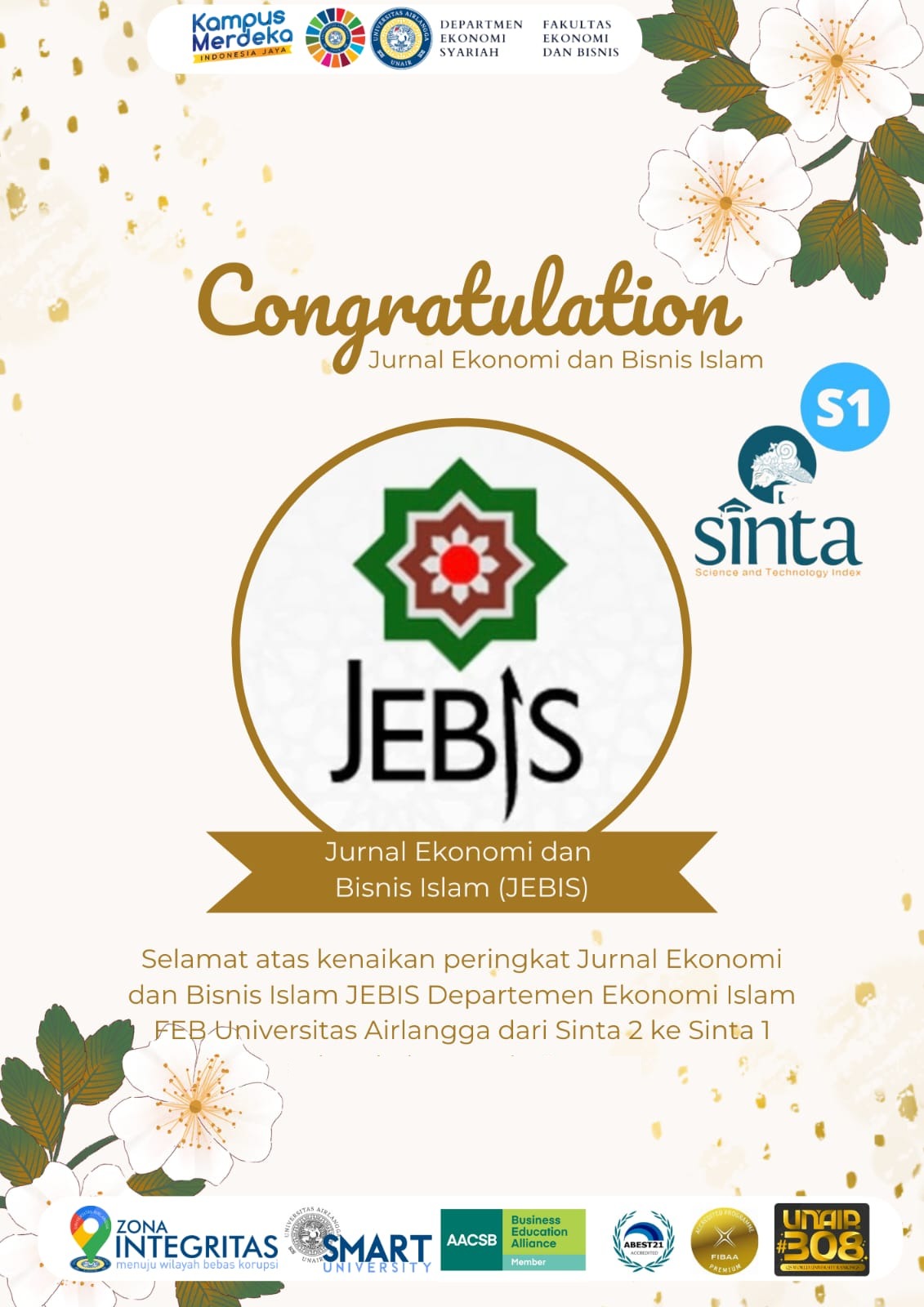WHAT DRIVES CONSUMERS IN USING DIGITAL APPS TO VISIT HALAL TOURISM IN EAST JAVA? OPTIMIZATION STRATEGY FROM UTAUT2 PERSPECTIVE
Downloads
This study aims to identify the factors influencing consumer behavioral intentions in using digital applications to visit halal tourist attractions using the UTAUT2 model approach. PLS-SEM was employed as the quantitative research method's evaluation model. 300 respondents, ranging in age from 17 to 65, were utilized as the sample. Using a Likert scale from 1 to 5, a scale generated from earlier research is used to measure each variable. The study's findings revealed that five UTAUT2 indicators”performance expectancy, effort expectancy, social influence, pricing value, and habit”positively influenced consumers' inclinations to use digital applications to visit halal tourism locations. Based on the IPMA test, the performance expectancy variable is the variable that has the highest level of importance. The results of this study can be used by halal tourism business actors and the government as a digital application strategy development to support the growth of halal tourism in East Java.
Abror, A., Wardi, Y., Trinanda, O., & Patrisia, D. (2019). The impact of Halal tourism,
customer engagement on satisfaction: moderating effect of religiosity. Asia Pacific
Journal of Tourism Research, 24(7), 633–643.
https://doi.org/10.1080/10941665.2019.1611609
Aduhene, D. T., & Osei-Assibey, E. (2021). Socio-economic impact of COVID-19 on Ghana's
economy: challenges and prospects. International Journal of Social Economics, 48(4),
–556. https://doi.org/10.1108/IJSE-08-2020-0582
Afshardoost, M., & Eshaghi, M. S. (2020). Destination image and tourist behavioural
intentions: A meta-analysis. Tourism Management, 81(December 2019), 104154.
https://doi.org/10.1016/j.tourman.2020.104154
Al-Qhardhawi, Y. (1994). Al-Halal wa al-Haram fi al-Islam. Maktabah al-Islami.
Alalwan, A. A., Dwivedi, Y. K., & Rana, N. P. (2017). Factors influencing adoption of mobile
banking by Jordanian bank customers: Extending UTAUT2 with trust. International
Journal of Information Management, 37(3), 99–110.
https://doi.org/10.1016/j.ijinfomgt.2017.01.002
Andrianto, A. (2020). Faktor Yang Mempengaruhi Behavior Intention Untuk Penggunaan
Aplikasi Dompet Digital Menggunakan Model Utaut2. Jurnal Ilmiah Ekonomi Bisnis,
(2), 111–122. https://doi.org/10.35760/eb.2020.v25i2.2412
Azam, M. S. E., Abdullah, M. A., & Razak, D. A. (2019). Halal Tourism: Definition,
Justification, and Scopes towards Sustainable Development. International Journal of
Business, Economics and Law, 18(3), 23–31. https://www.ijbel.com/wpcontent/uploads/2019/05/KLIBEL-18_64.pdf
Badan Pusat Statistik. (2020). Statistik Perkembangan Pariwisata dan Transportasi
Nasional November 2020. Berita Resmi Statistik, 110, 1–13.
Badan Pusat Statistik Provinsi Jawa Timur. (2020). Pertumbuhan Ekonomi Jawa Timur
Tahun 2019. Berita Resmi Statistik, 13(02), 10.
Battour, M., Mady, K., Salaheldeen, M., Elsotouhy, M., Elbendary, I., & Boğan, E. (2023).
AI-enabled technologies to assist Muslim tourists in Halal-friendly tourism. Journal of
Islamic Marketing, 14(5), 1291–1309. https://doi.org/10.1108/JIMA-01-2022-0001
Battour, M., Noviyani, N. A., Ratnasari, R. T., Aboelmaged, M., & Eid, R. (2022). The Impact
of HDA, Experience Quality, and Satisfaction on Behavioral Intention: Empirical
Evidence from West Sumatra Province, Indonesia. Sustainability (Switzerland), 14(8). https://doi.org/10.3390/su14084674
Battour, M., Salaheldeen, M., & Mady, K. (2022). Halal tourism: exploring innovative
marketing opportunities for entrepreneurs. Journal of Islamic Marketing, 13(4), 887–
https://doi.org/10.1108/JIMA-06-2020-0191
Berakon, I., Wibowo, M. G., Nurdany, A., & Aji, H. M. (2021). An expansion of the
technology acceptance model applied to the halal tourism sector. Journal of Islamic
Marketing. https://doi.org/10.1108/JIMA-03-2021-0064
Bhuiyan, A. H., & Darda, A. (2018). Prospects and Potentials of Halal Tourism Development
in Bangladesh. Prospects and Potentials of Halal Tourism Development in Bangladesh,
(2), 93–106. https://doi.org/10.26650/jot.2018.4.2.0007
Bolton, L. E. (2017). Behavioral pricing. Journal of Consumer Research Oxford Academy.
Crescentrating, M. (2023). Global Muslim Travel Index 2023 (Issue June).
Creswell, J. . (2014). Research Design: Qualitative, Quantitative and Mixed Methods
Approaches (4th ed.). Thousand Oaks, CA: Sage.
Darmansyah, Fianto, B. A., Hendratmi, A., & Aziz, P. F. (2020). Factors determining
behavioral intentions to use Islamic financial technology: Three competing models.
Journal of Islamic Marketing, 12(4), 794–812. https://doi.org/10.1108/JIMA-12-
-0252
Davis, F. D., Bagozzi, R. P., & Warshaw, P. R. (1989). User Acceptance of Computer
Technology: A Comparison of Two Theoretical Models. Management Science, 35(8),
–1003. https://doi.org/10.1287/mnsc.35.8.982
Deb, S. K., Nafi, S. M., & Valeri, M. (2022). Promoting tourism business through digital
marketing in the new normal era: a sustainable approach. European Journal of
Innovation Management. https://doi.org/10.1108/EJIM-04-2022-0218
Dinar Standard. (2022). State of the Global Islamic Economy Report 2022. Dubai
International Financial Centre, 112. https://haladinar.io/hdn/doc/report2018.pdf
Drosos, D., Chalikias, M., Skordoulis, M., Kalantonis, P., & Papagrigoriou, A. (2017). The
Strategic Role of Information Technology in Tourism: The Case of Global Distribution
Systems. Springer Proceedings in Business and Economics, 207–219.

This work is licensed under a Creative Commons Attribution-NonCommercial-ShareAlike 4.0 International License.
- Every manuscript submitted to JEBIS must obey to the policy and terms set by Journal of Economics and Business Islamic.
- Publication rights on the contents of manuscript published by JEBIS is owned by JEBIS under consent and approval by the corresponding author(s).
- Full text of electronic publication of manuscripts can be accessed free if used for the purpose of education and research according to copyright regulation.
- Share ” copy and redistribute the material in any medium or format
- Adapt ” remix, transform, and build upon the material
- You must give appropriate credit, provide a link to the license, and indicate if changes were made. You may do so in any reasonable manner, but not in any way that suggests the licensor endorses you or your use.
- You may not use the material for commercial purposes.
- If you remix, transform, or build upon the material, you must distribute your contributions under the same license as the original.
Creative Commons Attribution-NonCommercial-ShareAlike 4.0 International License.





.png)














